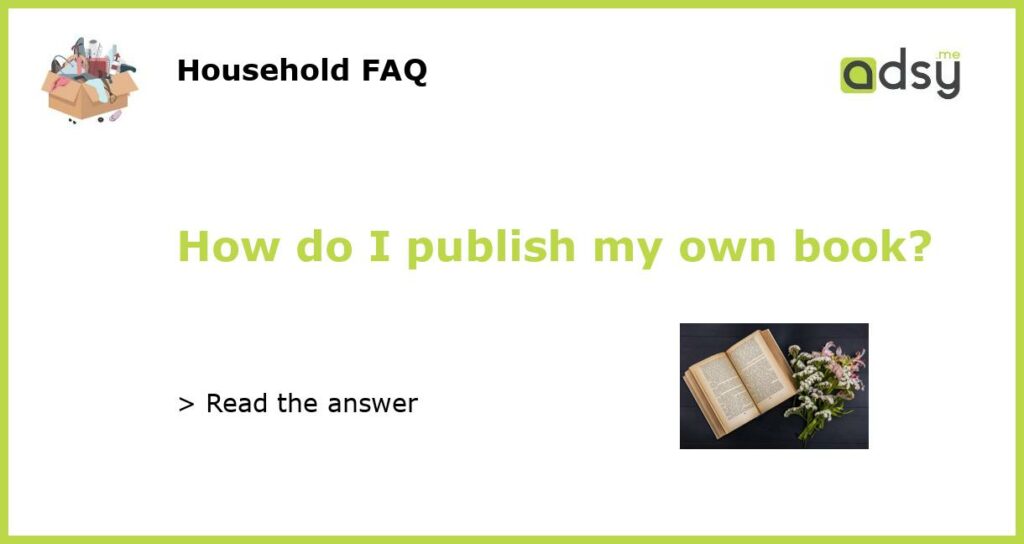Choosing a publishing option
Publishing your own book can be an exciting and rewarding journey. With self-publishing becoming increasingly popular, there are now more options than ever for aspiring authors. When it comes to publishing your own book, one of the first decisions you’ll need to make is which publishing option is right for you.
Traditional publishing, where you submit your manuscript to a publishing house for consideration, has long been the most popular route for authors. However, self-publishing has gained traction in recent years, giving authors greater control over the entire publishing process. Alternatively, hybrid publishing offers a middle ground between traditional and self-publishing.
If you choose to go down the traditional route, you will need to research and identify suitable publishers that align with your genre and writing style. Submit your manuscript to these publishers and hope for the best. Keep in mind that traditional publishing can be a long and competitive process, with no guarantee of success.
Self-publishing, on the other hand, allows you to maintain full control of your book’s production, distribution, and marketing. There are various platforms available, such as Amazon’s Kindle Direct Publishing (KDP) and Smashwords, that make self-publishing accessible and straightforward.
Hybrid publishing combines elements of traditional and self-publishing. With hybrid publishing, you generally pay a fee to work with a publishing company that provides services such as editing, design, and distribution. This option gives you more professional support while still retaining some control over the process.
Preparing your manuscript
Before you can publish your book, it’s essential to ensure your manuscript is polished and ready for publication. This involves several steps, including editing, proofreading, and formatting.
Editing is a crucial step in the publishing process. Consider hiring a professional editor who can provide objective feedback and help refine your writing. A thorough edit can improve the clarity, structure, and overall quality of your manuscript.
Proofreading is another important step to catch any grammar, spelling, or punctuation errors that may have been missed during the editing process. While you can proofread your manuscript yourself, it’s recommended to have a fresh set of eyes review it as well.
Formatting your manuscript is necessary to ensure it meets industry standards and is compatible with the publishing platform you choose. Different self-publishing platforms may have specific formatting guidelines, so be sure to review them carefully and make any necessary adjustments.
Once your manuscript is edited, proofread, and formatted, you’re ready to move on to the next step.
Designing a book cover
A visually appealing book cover plays a crucial role in attracting readers and generating interest in your book. When it comes to designing a book cover for self-published books, you have a few options.
One option is to hire a professional cover designer who specializes in book cover design. They will work with you to create a customized cover that matches the genre and tone of your book. Alternatively, you can use online tools and templates available on platforms like Canva to design your own cover.
Regardless of the method you choose, ensure that your book cover is visually engaging, includes relevant graphics or images, and has clear and legible typography. Remember, your book cover will be the first impression readers have of your book, so make it count.
Distributing and marketing your book
Once your manuscript is prepared, and your book cover is designed, it’s time to think about distribution and marketing strategies for your book.
If you choose to self-publish on platforms like Amazon’s KDP, your book will be available for purchase on the platform’s online store. Amazon’s vast customer base provides excellent exposure for your book. Additionally, you can explore other distribution platforms like Smashwords, where you can distribute your ebook to various online retailers.
Marketing your book is crucial for driving sales and gaining visibility. Consider creating an author website where readers can learn more about you and your book. Utilize social media platforms to engage with your target audience, share updates, and promote your book. Also, consider reaching out to book bloggers, submitting your book for reviews, and exploring paid advertising options.
Building an email list is another effective marketing strategy. Offer readers a free sample or bonus content in exchange for their email address, allowing you to communicate directly with potential readers and promote future releases.
Continuing the writing journey
Publishing your first book is a significant milestone, but the journey doesn’t end there. As an author, it’s important to continue writing and honing your craft.
Consider building a network of fellow authors and joining writing communities or critique groups. Attend writing conferences and workshops to learn from experienced authors and industry professionals. Continuously reading and exploring different genres can also help inspire and improve your writing.
Remember, the publishing industry is always evolving, so stay updated on industry trends and changes. Keep an open mind, embrace feedback, and never stop learning.
By choosing the right publishing option, preparing your manuscript, designing an eye-catching cover, effectively distributing and marketing your book, and continuing to grow as a writer, you can successfully navigate the process of publishing your own book.






